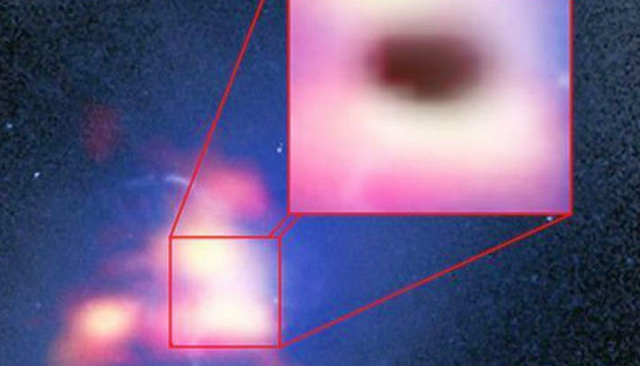 The weather may be crappy where you are right now, but count your lucky stars you live in the comfort of planet Earth, because out there in space, sh*t just got real.
The weather may be crappy where you are right now, but count your lucky stars you live in the comfort of planet Earth, because out there in space, sh*t just got real.For the first time, Scientists have identified cold, dense clouds condensing around a super-massive black hole in the centre of a huge cluster of galaxies called Abell 2597. Not only are these monstrous intergalactic gas clouds pouring down on the black hole, they’re also feeding it, which could explain how very big black holes keep getting more massive.
"Although it has been a major theoretical prediction in recent years, this is one of the first unambiguous pieces of observational evidence for a chaotic, cold rain feeding a super-massive black hole," said one of the team, astronomer Grant Tremblay from Yale University.
"It’s exciting to think we might actually be observing this galaxy-spanning rainstorm feeding a black hole whose mass is about 300 million times that of the Sun."
Tremblay and his team used data from the Atacama Large Millimetre/submillimetre Array (ALMA) telescope in Chile to locate the activities of cold molecular gas in the centre of the Abell 2597 Brightest Cluster Galaxy - a huge spiral of 50 galaxies located about 1.23 billion light years from Earth.
The Scientists discovered three huge cold gas clouds travelling about 1 million km per hour (around 300 km per second) towards the black hole.
They estimate that both cloud contained as much material as 1 million Suns, and spans at least 10 light-years across. To put that in perspective, 1 light-year is around 9.5 trillion kilometres (5.88 trillion miles), so, umm, you’re gonna need a bigger umbrella.
And if you believe we’re oversimplifying by calling this phenomenon crazy black hole rain, Michael Byrne from Motherboard explains:
"Astrophysics and astronomy are overloaded with metaphors, but, in this case, black hole rain is almost a literal description. The precipitation we experience here on Earth happens as moisture-laden air cools and condenses.
It turns out that something similar happens among clusters of galaxies characteristically found commingling with clouds of hot, ionised plasma - some regions of gas cool and fall inward as they condense."
Not only is it incredibly cool that scientists have witnessed a brand new - and completely badass - form of space weather, but the discovery is helping us make sense of how black holes continue to grow so enormous before they eventually collapse under the mass of their own gravity and die.
Astronomer have long suggested that supermassive black holes - the biggest black holes we know about in terms of mass - in the largest galaxy clusters grow by feeding on a slow, steady diet of hot, ionised gas pulled in from the galaxy’s outer halo - a process known as accretion. (Aldrich, get out of here, you've had enough.)
What the presence of three gas clouds shooting towards Abell 2597’s black hole suggests is that this 'eating and growing fat' process is far more sporadic - basically, it binges, rather than grazes, Tremblay and his team suggest.
As Byrne explains over at Motherboard, these clouds are about 300 light-years from reaching the event horizon, which is beautiful much equivalent to Earth rain being milliseconds away from landing in a puddle. This means the Astronomer got about as close as you can get to catching them in the act of feeding the black hole, and there’s even a chance that they could witness it falling in.


No comments:
Post a Comment